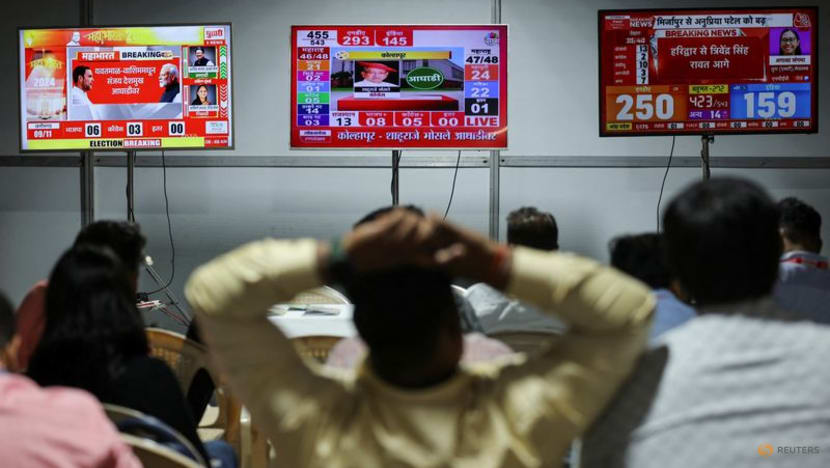Commentary: With Modi failing to secure landslide victory, India returns to default of coalition government
Coalition politics may restrain Prime Minister Narendra Modi's ruling BJP from pushing forward with the social and religious aspects of its agenda, says NUS Institute of South Asian Studies’ Iqbal Singh Sevea.

People watch election results outside a vote counting centre in Mumbai, India, Jun 4, 2024. REUTERS/Francis Mascarenhas

This audio is generated by an AI tool.
SINGAPORE: More than 640 million people voted in India’s election, making it the largest electoral exercise in the world. Yet, the election can perhaps best be described as one that returned India to its default setting of coalition governments.
Coalition governments have governed India from the 1980s to 2014 when the Bharatiya Janata Party (BJP) won an absolute majority under the leadership of Narendra Modi. Prime Minister Modi and the BJP repeated their success in 2019 when the party achieved a landslide victory, winning 303 seats.
This time, the BJP has again emerged as the largest party but its haul of 240 seats is below the 272-mark required to form the government. Thus, it is set to return to power as the leading party of the National Democratic Alliance (NDA).
NO MASSIVE WAVE OF SUPPORT FOR ANY PARTY
This election was normal because there was no massive wave of support for any party. In 2014, Mr Modi and the BJP’s promise to fight corruption won massive support. The incumbent coalition led by the Indian National Congress had been mired in corruption charges.
In 2019, the BJP rode to power on the back of a nationalist upsurge following a terrorist attack in Pulwama that killed 40 security personnel and the subsequent airstrike by India on alleged militant bases in Pakistan.
In contrast to these “wave” elections, the 2024 election was dominated by concerns over employment, inflation and local issues. Attempts to consolidate Hindu votes based on religious rhetoric and symbolism also did not bear fruit.
The BJP had hoped that the inauguration of a grand temple to the Hindu deity Lord Ram in the state of Uttar Pradesh by Mr Modi in January would lead to a groundswell of Hindu support. Evidence from the ground, however, suggests that this did not influence electoral choices.
While there was no wave of support for Mr Modi and the BJP, there was also no upsurge of anger against them. Voters were largely focused on their economic conditions, job prospects and the merits of individual candidates.
LOCALISED ELECTIONS
In 2014 and 2019, the staggering popularity of Mr Modi often ensured the victory of candidates, with voters indicating that they were supporting the prime minister rather than the local candidate. This time around, election choices were much more localised.
Rather than religion, caste dynamics have fundamentally influenced the results, especially so in Uttar Pradesh. With more representatives in the Lok Sabha (lower house of parliament) than any other state, Uttar Pradesh is the most politically important state in India.
The NDA has won 35 seats in Uttar Pradesh, while the Congress-led coalition, the Indian National Developmental Inclusive Alliance (INDIA), surprised most observers by emerging with 43 seats. This marks a drastic shift from the results of 2019. Then, the NDA had won 64 seats while the Congress and its allies only won 6.
In the absence of an overpowering national narrative, the strong performance of the INDIA in Uttar Pradesh was based on their focus on “rozi roti” (employment) and sewing up of caste alliances.
INDIA expanded its traditional voter base by drawing votes from Dalits who are considered the most marginalised. They did this by positioning themselves as champions of social justice and defenders of affirmative action built upon reservations for disadvantaged caste groups.
BRAND MODI HAS BEEN DENTED
As India returns to the era of coalition governments, the BJP will have to focus on managing allies who will certainly have a list of demands. However, with 240 seats, the BJP is by far the dominant partner. There is also every chance of other parties joining the NDA in the coming weeks offering their support.
As one can expect, the election results will give rise to questions over Mr Modi’s continued popularity. While he continues to be a popular political leader, Brand Modi has certainly been dented.
The aura of invincibility has been challenged and one can expect more vociferous opposition within and outside of parliament. Furthermore, as the head of a coalition government, Mr Modi will operate in a political milieu where his authority is somewhat curtailed and negotiated.
Overall, the restrictions of coalition politics may restrain the BJP from pushing forward with some of the social and religious aspects of its agenda. These include the introduction of a uniform civil code that will override provisions for religious groups like Muslims to be governed by their religious laws.
On the other hand, the fact that there is a broad consensus amongst parties across the political spectrum on issues relating to the economy and foreign policy means that we are unlikely to see any dramatic reversal in these spheres.
The new government will continue to develop its relations with the United States, push for a greater role in multilateral bodies like the United Nations Security Council and develop India’s engagement with other Asian states. Geopolitical realities are likely to ensure continuity.
Iqbal Singh Sevea is Associate Professor and Director of the Institute of South Asian Studies, National University of Singapore.















